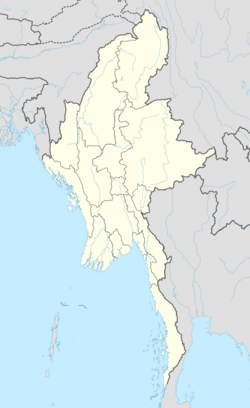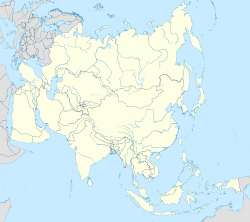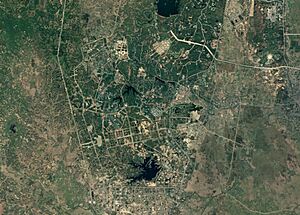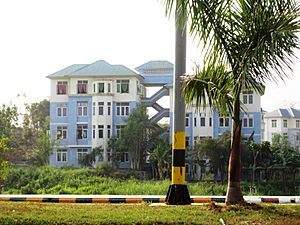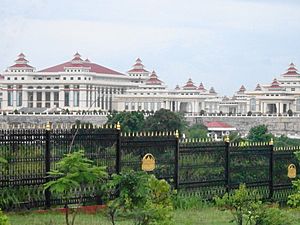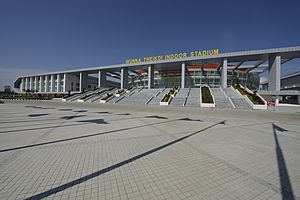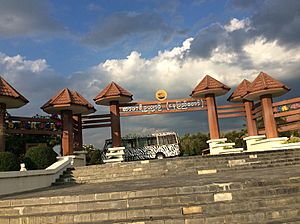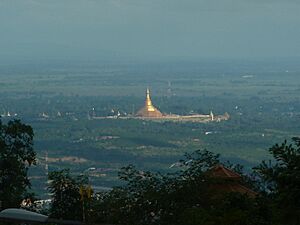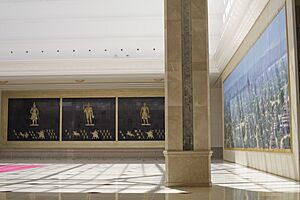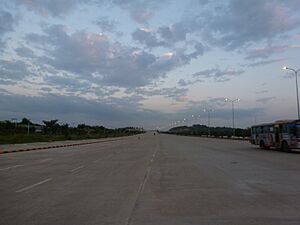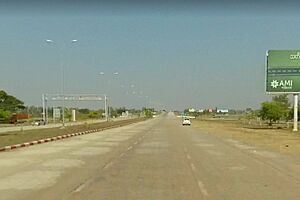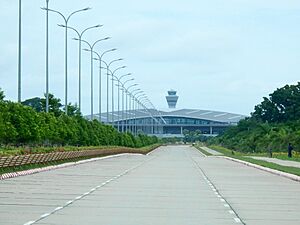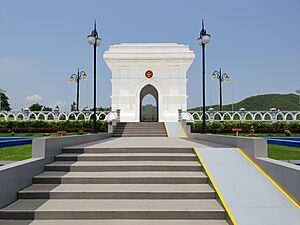Naypyidaw facts for kids
Quick facts for kids
Naypyidaw
နေပြည်တော်
NPT
|
|
|---|---|
|
Capital city
|
|
| Nay Pyi Taw | |

Clockwise from top: Uppatasanti Pagoda, Water Fountain Garden, Ministry Zone, Gems Museum, Union Parliament
|
|
| Country | |
| Division | Naypyidaw Union Territory |
| Subdivisions | 8 townships |
| Settled | 2005 |
| Incorporated | 2008 |
| Seat | Nay Pyi Taw City Hall |
| Government | |
| • Body | Naypyidaw Development Committee |
| Area | |
| • Total | 7,054.37 km2 (2,723.71 sq mi) |
| Elevation | 115 m (377 ft) |
| Population | |
| • Total | 924,608 |
| • Density | 131.1/km2 (339.5/sq mi) |
| Time zone | UTC+06:30 (MMT) |
| Area code(s) | 067 |
Naypyidaw (also called Nay Pyi Taw) is the capital city of Myanmar. It is also the third-largest city in the country. The city is located right in the middle of the Naypyidaw Union Territory.
What makes Naypyidaw special is that it's a completely planned city. It was built from scratch and isn't part of any existing state or region. Naypyidaw officially became the capital on November 6, 2005. Before that, Yangon was the capital.
As the center of Myanmar's government, Naypyidaw is home to important buildings. These include the Union Parliament, the Supreme Court, and the Presidential Palace. Many government offices and military headquarters are also here. Naypyidaw is known for being very large but having a low population for its size.
The city has hosted many important events. These include the ASEAN Summit and the 2013 Southeast Asian Games.
Contents
- What Does Naypyidaw Mean?
- History of Naypyidaw
- Geography and Climate
- City Layout and Zones
- How Naypyidaw is Governed
- Getting Around Naypyidaw: Transport
- Learning and Research
- Healthcare Services
- Sports in Naypyidaw
- Places to Visit
- Arts and Entertainment
- Media and Communication
- Costs and Challenges
- Images for kids
- See also
What Does Naypyidaw Mean?
The name Naypyidaw comes from the Burmese words for "abode of the king." It is often translated as "royal capital" or "seat of the king." In the past, this term was added to the names of royal capitals. For example, Mandalay was once called Yattanarbon Naypyidaw.
History of Naypyidaw
Naypyidaw was built on a new piece of land near Pyinmana. This area is about 320 kilometers (200 miles) north of the old capital, Yangon. Construction started in 2002 and finished by 2012. Many construction companies helped build the city. It is thought that building the city cost around US$4 billion.
On March 27, 2006, a big military parade took place in the new capital. Over 12,000 troops marched to celebrate Armed Forces Day. This day remembers Myanmar's 1945 revolution against the Japanese occupation. During these ceremonies, the city was officially named Naypyidaw. The country's capital was then moved from Yangon to Naypyidaw.
Why Was the Capital Moved?
There are a few reasons why the capital was moved. Naypyidaw is more in the center of the country than Yangon. It is also a transportation hub close to the Shan, Kayah, and Kayin states. Leaders felt that having a stronger military and government presence nearby might help bring stability to these areas.
Another reason given was that Yangon had become too crowded. There was not enough space to expand government offices in the future.
Geography and Climate
Naypyidaw is located between the Bago Yoma and Shan Yoma mountain ranges. The city covers an area of 7,054 square kilometers (2,724 square miles). It has a population of 924,608 people.
Several dams are located near Naypyidaw. The Chaungmagyi Dam is a few kilometers north, and the Ngalaik Dam is a few kilometers south. The Yezin Dam is further to the northeast.
Naypyidaw has a tropical savanna climate. This means it has hot temperatures all year round. It also has a wet season and a dry season.
| Climate data for Naypyidaw | |||||||||||||
|---|---|---|---|---|---|---|---|---|---|---|---|---|---|
| Month | Jan | Feb | Mar | Apr | May | Jun | Jul | Aug | Sep | Oct | Nov | Dec | Year |
| Mean daily maximum °C (°F) | 32 (90) |
35 (95) |
38 (100) |
39 (102) |
37 (99) |
34 (93) |
33 (91) |
33 (91) |
34 (93) |
35 (95) |
34 (93) |
32 (90) |
34.5 (94.1) |
| Daily mean °C (°F) | 23 (73) |
25 (77) |
29 (84) |
32 (90) |
31 (88) |
29 (84) |
29 (84) |
28 (82) |
29 (84) |
29 (84) |
27 (81) |
24 (75) |
27.9 (82.2) |
| Mean daily minimum °C (°F) | 16 (61) |
17 (63) |
21 (70) |
25 (77) |
26 (79) |
26 (79) |
25 (77) |
25 (77) |
25 (77) |
24 (75) |
22 (72) |
18 (64) |
22.5 (72.5) |
| Average precipitation mm (inches) | 5 (0.2) |
2 (0.1) |
9 (0.4) |
33 (1.3) |
154 (6.1) |
160 (6.3) |
198 (7.8) |
229 (9.0) |
186 (7.3) |
131 (5.2) |
37 (1.5) |
7 (0.3) |
1,151 (45.5) |
| Average precipitation days | 1 | 0 | 1 | 3 | 14 | 21 | 23 | 24 | 19 | 12 | 4 | 1 | 123 |
| Source: Weather2Travel.com. Retrieved 26 March 2013 | |||||||||||||
City Layout and Zones
Naypyidaw is divided into several different zones.
Where People Live: Residential Zones
The residential areas are very organized. Apartments are given out based on a person's job and whether they are married. The city has 1,200 apartment buildings, each with four stories. The roofs of these buildings are color-coded by the jobs of the people living there. For example, health ministry workers live in buildings with blue roofs. Agriculture ministry workers live in buildings with green roofs. High-ranking government officials live in large mansions.
Government Buildings: Ministry Zone
The Ministry Zone holds the main offices for Myanmar's government ministries. All the ministry buildings look the same. This zone also has a large parliamentary complex with 31 buildings. There is also a 100-room presidential palace. The city hall building is here too. It has a unique design with a Burmese-style roof.
Military Areas: Military Zone
High-ranking military officers and other important officials live about 11 kilometers (7 miles) away from regular government workers. This area is said to have tunnels and bunkers. It is closed to the public. The city also has a military base that ordinary citizens cannot enter without special permission.
International Presence: Diplomatic Zone
The government has set aside land for foreign embassies and United Nations offices. The Chinese embassy opened its first office here in 2017. This was the first foreign office allowed to open in Naypyidaw. Other countries like Bangladesh and Malaysia have also agreed to open embassies. Many other countries are also thinking about moving their embassies to Naypyidaw.
Hotels and Places to Stay: Hotel Zone
The Hotel Zone has several villa-style hotels on the city's hilly edges. There are twelve hotels in or near Naypyidaw. Many villas were built for the 25th ASEAN summit in 2014. More hotels and inns were built for the 2013 Southeast Asian Games.
Shopping and Markets
Naypyidaw Myoma Market is the main shopping area. Other places to shop include Thapye Chaung Market and Junction Centre Naypyidaw. Junction Centre was the city's first private shopping mall. There are also local markets and places to eat.
Fun and Recreation
The Ngalaik Lake Gardens is a small water park. It is located near the Ngalaik Dam, about 11 kilometers (7 miles) from Naypyidaw. It opened in 2008 and has water slides and natural resorts.
Also opened in 2008, the National Herbal Park covers 81 hectares (200 acres). It shows plants with medicinal uses from all over Myanmar. There are thousands of plants and hundreds of different species. Behind the city hall, there is a park with a playground and a water fountain complex. This fountain has a musical light show every night.
The Naypyidaw Zoological Gardens opened in 2008. It has over 1,500 animals, including a special climate-controlled penguin house. The animals were moved here from the old zoo in Yangon. The Naypyidaw Safari Park opened in 2011.
Naypyidaw also has two golf courses and a gem museum.
Important Landmark: Uppatasanti Pagoda
The Uppatasanti Pagoda was finished in 2009. It looks very similar in size and shape to the famous Shwedagon Pagoda in Yangon. This new pagoda is called the "Peace Pagoda." It is only 30 centimeters (12 inches) shorter than the Shwedagon Pagoda. The name Uppatasanti means "Protection against Calamity." It refers to a special prayer used during times of crisis.
How Naypyidaw is Governed
The Naypyidaw Union Territory is managed by two main groups. The Naypyidaw Council (NPTC) handles the region's overall administration. It works under the direct supervision of the President of Myanmar. The council helps with planning, security, and managing government services.
The Naypyidaw Development Committee (NPTDC) is the local government. It deals with things like urban planning, managing traffic, and public works like roads and water supply. The person who leads both the Council and the Committee is the Mayor of Naypyidaw.
Administrative Divisions
Naypyidaw Union Territory is divided into 2 districts and 8 townships. Some of these townships, like Pyinmana, Lewe, and Tatkone, were already existing. Others, such as Ottarathiri and Dekkhinathiri, are new townships that were built as part of the city.
Getting Around Naypyidaw: Transport
Roads
A four-lane highway connects Naypyidaw directly to Yangon. This highway is part of the longer Yangon-Naypyidaw-Mandalay Expressway. Naypyidaw itself has a very wide 20-lane boulevard. Like most roads in the city, it is often quite empty. The city also has four-lane roads and roundabouts decorated with flowers.
Air Travel
Nay Pyi Taw International Airport opened in December 2011. It is about 10 kilometers (6 miles) southeast of the city. The airport has flights to Yangon and other cities in Myanmar. It also has international flights to cities like Bangkok and Kunming. The airport has a long runway and a tall control tower.
Buses and Taxis
Public transport between different parts of the city is limited. Government ministries run shuttle buses for their employees in the mornings and evenings. There is one taxi company, which is run by the military. Motorbikes are not allowed on some roads in Naypyidaw due to past accidents.
Train Travel
Naypyidaw Central railway station opened in 2009. It is on the main railway line that connects Yangon to Mandalay. Before this station opened, people used the Pyinmana and Lewe stations. A train journey from Yangon to Pyinmana takes about nine hours.
In 2011, there was a plan to build an underground train system in Naypyidaw. However, this plan was later canceled because there wasn't enough demand or money.
Learning and Research
Universities and Colleges
- University of Veterinary Science, Yezin
- Yezin Agricultural University
- University of Forestry, Yezin
- University of Technology
- Naypyitaw State Academy
Research Centers
- Forest Research Institute (FRI), Yezin
- Department of Agricultural Research (DAR), Yezin
- Southeast Asia Biodiversity Research Institute (SABRI)
Healthcare Services
Naypyidaw has several public hospitals. These include the 1000-bed Naypyidaw General Hospital and the Naypyidaw Women Hospital. There are also specialized hospitals for ear, nose, and throat issues, traditional medicine, and orthopedics. The military also has a large hospital that is used for teaching.
Sports in Naypyidaw
Naypyidaw F.C. is a football club based in Naypyidaw. They play in the Myanmar National League. Their home stadium is the Wunna Theikdi Stadium.
Places to Visit
Religious Sites
- Uppatasanti Pagoda
- Maha Thetkya Yanthi Buddha
- Thatta Thattaha Maha Bawdi Pagoda (a copy of the Buddha Gaya temple)
- Maravijaya Buddha
Museums and Memorials
- Memorial to the Fallen Heroes
- National Museum
- Defence Services Museum
- Naypyidaw Gems Museum
- Planetarium
- The Museum of Sport
Recreation and Fun
- Naypyidaw Safari Park
- National Herbal Park
- Naypyidaw Zoological Gardens
- Naypyidaw Water Fountain Garden
- National Landmark Garden
- Naypyidaw Hot Spring Resort
- Wunna Theikdi Stadium
- Wunna Theikdi Indoor Stadium
- Zayarthiri Stadium
Concert Halls and Theatres
- Myanmar International Convention Centre 1 (MICC-1)
- Myanmar International Convention Centre 2 (MICC-2)
- Open-Air Theatre
Arts and Entertainment
The Myanmar Motion Picture Academy Awards are held every year in Naypyidaw. These awards celebrate the best movies in Burmese cinema. There are movie theaters in the Junction Centre Mall and the Ocean Supercenter.
Media and Communication
The main office for the Ministry of Information is in Naypyidaw. Mobile phone service has been available in Naypyidaw since 2009.
Newspapers
Newspapers like Myanmar Alin and Kyaymon (in Burmese) and the New Light of Myanmar (in English) are available. The Ministry of Information also publishes a weekly journal called the Naypyidaw Times.
Radio Stations
Many AM and FM radio stations broadcast in Naypyidaw. Some popular ones include Myanmar Radio, Cherry FM, and Mandalay FM.
Television Channels
MRTV, MRTV-4, and MWD are the main TV channels. They show programs in Burmese. A private company called Sky Net offers many pay-TV channels. Other channels like Channel 7 and Myanmar International are also available.
Costs and Challenges
It is estimated that building Naypyidaw cost between $3 billion and $4 billion US dollars.
The highway from Yangon to Naypyidaw is 300 kilometers (186 miles) long and mostly has four lanes. However, it often has very few cars. Most trucks going north are not allowed to use this highway. Experts believe that allowing more trucks on the road would save a lot of money and time. There are plans to make the road even safer by adding more lanes.
Finding housing for people from other countries can be difficult. This is because most of the apartments were built for government employees.
Images for kids
See also
 In Spanish: Naipyidó para niños
In Spanish: Naipyidó para niños


